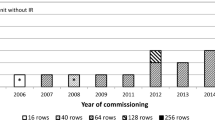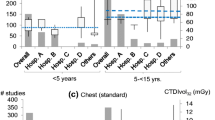Abstract
Objectives
To benchmark regional standard practice for paediatric cranial CT-procedures in terms of radiation dose and acquisition parameters.
Methods
Paediatric cranial CT-data were retrospectively collected during a 1-year period, in 3 different hospitals of the same country. A dose tracking system was used to automatically gather information. Dose (CTDI and DLP), scan length, amount of retakes and demographic data were stratified by age and clinical indication; appropriate use of child-specific protocols was assessed.
Results
In total, 296 paediatric cranial CT-procedures were collected. Although the median dose of each hospital was below national and international diagnostic reference level (DRL) for all age categories, statistically significant (p-value < 0.001) dose differences among hospitals were observed. The hospital with lowest dose levels showed smallest dose variability and used age-stratified protocols for standardizing paediatric head exams. Erroneous selection of adult protocols for children still occurred, mostly in the oldest age-group.
Conclusion
Even though all hospitals complied with national and international DRLs, dose tracking and benchmarking showed that further dose optimization and standardization is possible by using age-stratified protocols for paediatric cranial CT. Moreover, having a dose tracking system revealed that adult protocols are still applied for paediatric CT, a practice that must be avoided.
Key Points
• Significant differences were observed in the delivered dose between age-groups and hospitals.
• Using age-adapted scanning protocols gives a nearly linear dose increase.
• Sharing dose-data can be a trigger for hospitals to reduce dose levels.






Similar content being viewed by others
References
UNSCEAR (2008) Report to the General Assembly with Scientific Adnexes. Sources and effects of ionizing radiation. Volume 1
Pearce MS, Salotti JA, Little MP et al (2012) Radiation exposure from CT scans in childhood and subsequent risk of leukaemia and brain tumours: a retrospective cohort study. Lancet 380:499–505
Mathews JD, Forsythe AV, Brady Z et al (2013) Cancer risk in 680,000 people exposed to computed tomography scans in childhood or adolescence: data linkage study of 11 million Australians. BMJ 346:f2360
Brenner D, Elliston C, Hall E, Berdon W (2001) Estimated risks of radiation-induced fatal cancer from pediatric CT. AJR Am J Roentgenol 176:289–296
ICRP (1996) Radiological Protection and Safety in Medicine. ICRP Publication 73. Ann ICRP 26 (2)
Slovis TL (2002) The ALARA concept in pediatric CT: myth or reality? Radiology 223:5–6
Directorate-General, Environment, Nuclear Safety and Civil Protection, European Commission. Radiation protection 109: guidance on diagnostic reference levels (DRLs) for medical exposures (radiation protection). Available at http://ec.europa.eu/energy/nuclear/radiation_protection/doc/publication/109_en.pdf. Published 1999
Verdun FR, Gutierrez D, Vader JP et al (2008) CT radiation dose in children: a survey to establish age-based diagnostic reference levels in Switzerland. Eur Radiol 18:1980–1986
Galanski M, Nagel HD, Stamm G (2007) Results of a federation inquiry 2005/2006: pediatric CT X-ray practice in Germany. Röfo 179:1110–1111
Brisse HJ, Aubert B (2009) CT exposure from pediatric MDCT: results from the 2007-2008 SFIPP/ISRN survey. J Radiol 90:207–215
Buls N, Bosmans H, Mommaert C et al (2009) Current status on pediatric CT doses: a multicentre study (Belgium). RSNA meeting, Chicago. Available at: www.fanc.fgov.be/GED/00000000/2400/2449.pdf
Federal Office for Radiation Protection (2010) Notice of diagnostic reference levels for radiology and nuclear medicine examinations. [In German.] Salzgitter, Germany: Federal Office for Radiation Protection
Larson DB, Johnson LW, Schnell BM, Goske MJ, Salisbury SR, Forman HP (2011) Rising use of CT in child visits to the emergency department in the United States, 1995-2008. Radiology 259:793–801
Larson DB, Molvin LZ, Wang J, Chan FP, Newman B, Fleischmann D (2014) Pediatric CT quality management and improvement program. Pediatr Radiol 44(Suppl 3):519–524
Watson DJ, Coakley KS (2010) Paediatric CT reference doses based on weight and CT dosimetry phantom size: local experience using a 64-slice CT scanner. Pediatr Radiol 40:693–703
Pages J, Buls N, Osteaux M (2003) CT doses in children: a multicentre study. Br J Radiol 76:803–811
Singh S, Kalra MK (2014) Standardized CT protocols and nomenclature: better, but not yet there. Pediatr Radiol 44(Suppl 3):440–443
Kanal KM, Graves JM, Vavilala MS, Applegate KE, Jarvik JG, Rivara FP (2015) Variation in CT pediatric head examination radiation dose: results from a national survey. AJR Am J Roentgenol 204:W293–W301
Shrimpton PC, Hillier MC, Lewis MA, Dunn M (2006) National survey of doses from CT in the UK: 2003. Br J Radiol 79:968–980
Arch ME, Frush DP (2008) Pediatric body MDCT: a 5-year follow-up survey of scanning parameters used by pediatric radiologists. AJR Am J Roentgenol 191:611–617
Treier R, Aroua A, Verdun FR, Samara E, Stuessi A, Trueb PR (2010) Patient doses in CT examinations in Switzerland: implementation of national diagnostic reference levels. Radiat Prot Dosim 142:244–254
Shrimpton PC, Hillier MC, MeesonS and Golding SJ. Doses from Computed Tomography (CT) Examinations in the UK – 2011 Review. Available at: https://www.gov.uk/government/uploads/system/uploads/attachment_data/file/349188/PHE_CRCE_013.pdf
Roch P, Aubert B (2013) French diagnostic reference levels in diagnostic radiology, computed tomography and nuclear medicine: 2004-2008 review. Radiat Prot Dosim 154:52–75
Australian Radiation Protection and nuclear safety agency (2013) National Diagnositic Reference Level Fact Sheet. Available at: http://www.arpansa.gov.au/services/ndrl/adult.cfm
Santos J, Foley S, Paulo G, McEntee MF, Rainford L (2014) The establishment of computed tomography diagnostic reference levels in Portugal. Radiat Prot Dosim 158:307–317
Dosimétrie de patients en radiologie, Belgium 2014 (French). Available at: http://www.fanc.fgov.be/fr/page/dosimetrie-des-patients-en-radiologie/1196.aspx#P_8196
Graves JM, Kanal KM, Rivara FP, Jarvik JG, Vavilala MS (2014) Dose reduction efforts for pediatric head CT imaging in Washington State trauma centers: follow-up survey results. J Am Coll Radiol 11:161–168 e163
Sharp NE, Svetanoff WJ, Desai A et al (2014) Radiation exposure from head computed tomography scans in pediatric trauma. J Surg Res 192:276–279
McKnight CD, Watcharotone K, Ibrahim M, Christodoulou E, Baer AH, Parmar HA (2014) Adaptive statistical iterative reconstruction: reducing dose while preserving image quality in the pediatric head CT examination. Pediatr Radiol 44:997–1003
Agence fédérale de controle nucléaire. Dosimétrie de patients en radiologie en Belgique (article in French). Agence fédérale de controle nucléaire, Brussels. Available at: http://www.fanc.fgov.be/fr/page/dosimetrie-des-patients-enradiologie/1196.aspx. Accessed 28 May 2015
Paolicchi F, Faggioni L, Bastiani L et al (2014) Optimizing the balance between radiation dose and image quality in pediatric head CT: findings before and after intensive radiologic staff training. AJR Am J Roentgenol 202:1309–1315
WHO (2013) Technical meeting report 2008. Global initiative on radiation safety in health settings. IAEA/WHO. Radiation protection of patients. In: Joint IAEA and WHO position statement on the Bonn call-for-action
MacGregor K, Li I, Dowdell T, Gray BG (2015) Identifying institutional diagnostic reference levels for CT with radiation dose index monitoring software. Radiology 276:507–517
Hart D, Wall BF (2004) UK population dose from medical X-ray examinations. Eur J Radiol 50:285–291
McCrohan JL, Patterson JF, Gagne RM, Goldstein HA (1987) Average radiation doses in a standard head examination for 250 CT systems. Radiology 163:263–268
Pantos I, Thalassinou S, Argentos S, Kelekis NL, Panayiotakis G, Efstathopoulos EP (2011) Adult patient radiation doses from non-cardiac CT examinations: a review of published results. Br J Radiol 84:293–303
Muhogora WE, Ahmed NA, Almosabihi A et al (2008) Patient doses in radiographic examinations in 12 countries in Asia, Africa, and Eastern Europe: initial results from IAEA projects. AJR Am J Roentgenol 190:1453–1461
Shrimpton PC, Jones DG, Hillier MC, Wall BF, Le Heron JC, Faulkner K (1991) Survey of CT practice in the UK. Part 2. Dosimetric aspects. Chilton, UK: National Radiological Protection Board, 1991: report NRPB-R249
Brink JA (2014) Clinical decision-making tools for exam selection, reporting and dose tracking. Pediatr Radiol 44(Suppl 3):418–421
Winkler NT (1980) ALARA concept--now a requirement. Radiol Technol 51:525
Acknowledgments
The scientific guarantor of this publication is prof. Dr. Paul M Parizel. The authors of this manuscript declare relationships with the following companies: Federica Zanca is an employee of General Electric. The authors state that this work has not received any funding. One of the authors has significant statistical expertise. Institutional Review Board approval was obtained. Written informed consent was waived by the Institutional Review Board. Methodology: retrospective, cross sectional study, multicenter study.
Author information
Authors and Affiliations
Corresponding author
Rights and permissions
About this article
Cite this article
De Bondt, T., Mulkens, T., Zanca, F. et al. Benchmarking pediatric cranial CT protocols using a dose tracking software system: a multicenter study. Eur Radiol 27, 841–850 (2017). https://doi.org/10.1007/s00330-016-4385-4
Received:
Revised:
Accepted:
Published:
Issue Date:
DOI: https://doi.org/10.1007/s00330-016-4385-4




